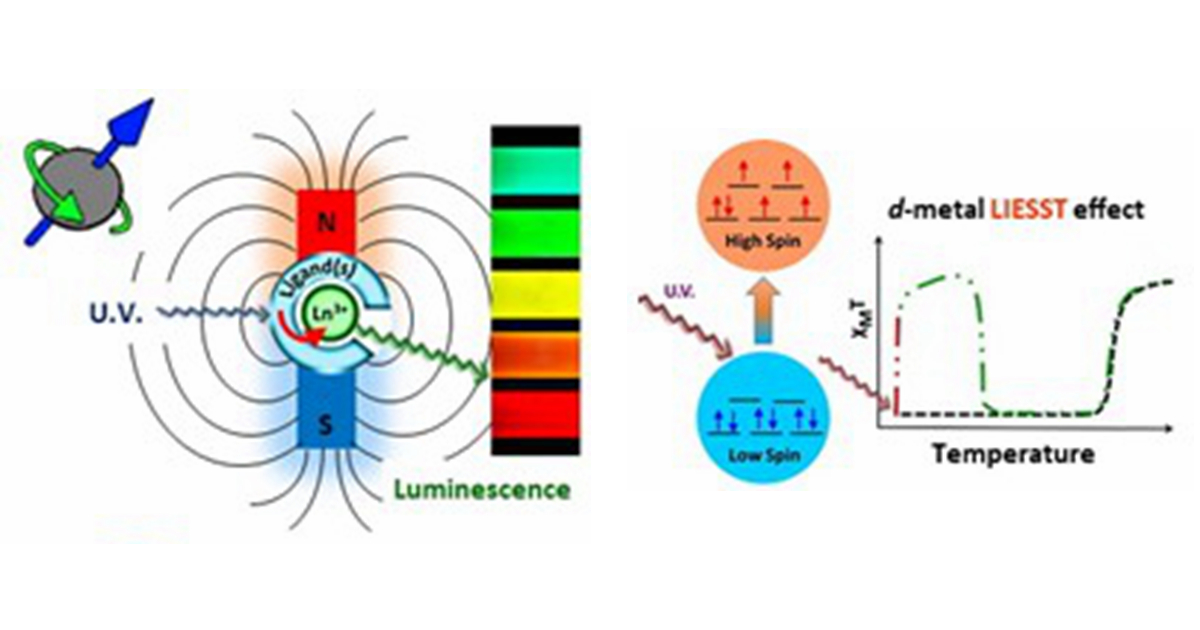Photofunctional Molecular Magnets: Development and Their Potential Applications
A special issue of Magnetochemistry (ISSN 2312-7481). This special issue belongs to the section "Magnetic Materials".
Deadline for manuscript submissions: closed (20 June 2023) | Viewed by 7545

Special Issue Editors
Interests: multifunctional and nanostructured materials; molecular magnetism; magnetic properties of materials; chemistry and physics of f-elements
Special Issues, Collections and Topics in MDPI journals
Interests: functionalization and characterization of hybrid materials; molecular magnetism; lanthanide chemistry; multifunctional materials; luminescence; supramolecular chemistry; environmental applications; optical sensors
Special Issues, Collections and Topics in MDPI journals
Interests: lanthanide chemistry; optical sensors; dye sensitized solar cells; luminescence; photoconversion
Special Issues, Collections and Topics in MDPI journals
Special Issue Information
Dear Colleagues,
Nowadays the development of functional molecular magnets is becoming one of the main challenges for chemists, physics, and materials researchers. Molecular magnetic materials are essentially based on molecular building blocks where their properties can be tuned/modulated from thousands of small variations that organic/inorganic ligands may present, giving rise to an incredibly rich structural diversity. In these materials, the transition metals or lanthanide ions provide the localized moment, and the ligands act as exchange pathways, changing the intermolecular interactions and allowing possible observation of physical properties other than magnetic by external stimuli, such as light, pressure, temperature, etc.
Among these materials, photofunctional magnets are gaining prominence, as photo-switching materials induce magnetic behavior or clearly show both magnetic and luminescence properties, which is the case of some lanthanide-based single-molecule magnets. Their excellent performances have shown great potential in applications such as high-density data storage, quantum computing, sensing, optical switches, biomedicine, etc.
This Special Issue of Magnetochemistry aims at publishing a collection of research contributions illustrating recent achievements in the development of molecular magnets where the presence of photofunctional properties can coexist, as well as their potential applications, namely in the topics listed below:
- transition metal and lanthanide chemistry;
- photofunctional molecular magnets;
- photoswitching of single-molecule magnets;
- lanthanide luminescent single-molecule magnets;
- photo-switched spin-crossover complexes;
- magnetochiral dichroism;
- magnetic ionic liquids;
- magnetic and optical sensors;
- phototunable MOFs;
- applications of photofunctional molecular materials
Dr. Laura Cristina de Jesus Pereira
Dr. Bernardo Monteiro
Dr. Cláudia Pereira
Guest Editors
Manuscript Submission Information
Manuscripts should be submitted online at www.mdpi.com by registering and logging in to this website. Once you are registered, click here to go to the submission form. Manuscripts can be submitted until the deadline. All submissions that pass pre-check are peer-reviewed. Accepted papers will be published continuously in the journal (as soon as accepted) and will be listed together on the special issue website. Research articles, review articles as well as short communications are invited. For planned papers, a title and short abstract (about 100 words) can be sent to the Editorial Office for announcement on this website.
Submitted manuscripts should not have been published previously, nor be under consideration for publication elsewhere (except conference proceedings papers). All manuscripts are thoroughly refereed through a single-blind peer-review process. A guide for authors and other relevant information for submission of manuscripts is available on the Instructions for Authors page. Magnetochemistry is an international peer-reviewed open access monthly journal published by MDPI.
Please visit the Instructions for Authors page before submitting a manuscript. The Article Processing Charge (APC) for publication in this open access journal is 2200 CHF (Swiss Francs). Submitted papers should be well formatted and use good English. Authors may use MDPI's English editing service prior to publication or during author revisions.
Keywords
- transition metal and lanthanide chemistry
- photofunctional molecular magnets
- photoswitching of single-molecule magnets
- lanthanide luminescent single-molecule magnets
- photo-switched spin-crossover complexes
- magnetochiral dichroism
- magnetic ionic liquids
- magnetic and optical sensors
- phototunable MOFs
- applications of photofunctional molecular materials
Benefits of Publishing in a Special Issue
- Ease of navigation: Grouping papers by topic helps scholars navigate broad scope journals more efficiently.
- Greater discoverability: Special Issues support the reach and impact of scientific research. Articles in Special Issues are more discoverable and cited more frequently.
- Expansion of research network: Special Issues facilitate connections among authors, fostering scientific collaborations.
- External promotion: Articles in Special Issues are often promoted through the journal's social media, increasing their visibility.
- e-Book format: Special Issues with more than 10 articles can be published as dedicated e-books, ensuring wide and rapid dissemination.
Further information on MDPI's Special Issue polices can be found here.







